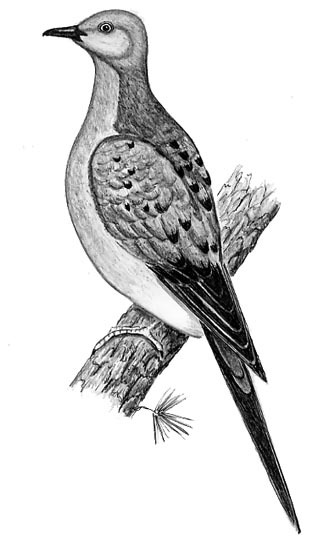Dear Bird Folks,
With all the excitement about the possible existence of the Ivory-billed Woodpecker, I’ve been thinking about the Passenger Pigeon. It is a big world out there. Do you think there is any chance that in some isolated location someplace, a small population of Passenger Pigeons still exists?
– Pam, Norwalk, CT
I’ve been waiting, Pam,
I’ve been waiting for this question to pop up. It’s not that I was looking forward to writing about Passenger Pigeons. I’m not. I just figured that once the ivory-bill rumors began to surface, people would start wondering about other things that no longer exist, like wooly mammoths, unicorns, and products that are made in the United States. Well, Pam, I can tell you right now there is a better chance that you’ll see a unicorn riding on the back of wooly mammoth before you ever see a living Passenger Pigeon. How’s that for a downer of an opening paragraph? Well, guess what. It’s not going to get any better.

The reason we have hope for the Ivory-billed Woodpecker is because they are secretive birds. They live in deep, mostly inaccessible swamps, which are only inhabited by snakes and moonshiners. Proving the ivory-bill’s existence is extremely difficult since moonshiners don’t like to talk and the snakes aren’t always truthful. (Just ask Eve.) Passenger Pigeons, on the other hand, were birds of forests. They didn’t hide, ever. They were active, noisy, and super gregarious. These birds made both Shriners and members of the Red Hat Society look like mute recluses.
One may think that it would be a disadvantage for a bird to be so obvious, as they would be easy targets for predators. But this was not the case with the Passenger Pigeon. Their loud, partying ways made them one of the most abundant birds in the entire world.
How abundant were the Passenger Pigeons? Well, Carl Sagan would have loved these birds as their numbers were actually in the “billions and billions.” Yes, really, billions. It is thought that when the settlers arrived, over 25% of the total number of North American birds were Passenger Pigeons. If you read an account by an early naturalist about the numbers of these birds, you would think the naturalist was either making it up or had found some of that moonshine I mentioned earlier. But year after year, account after account, naturalists from all over the eastern part of North America all reported the same staggering numbers.
Our old buddy, John James Audubon, once witnessed a flying river of birds that he estimated to be a mile wide and 180 miles long. Others reported flocks 300 miles long. Several others claimed to have watched a flock so massive that it took three days to pass overhead. When a flock finally landed and stopped to roost for the night, thousands of birds would stack themselves onto the thickest branches of the trees, only to have many of the branches snap under the sheer weight of the resting pigeons. It was also reported that when one huge flock visited a town, an outraged early colonist went to his local birding shop to complain that the twenty million Passenger Pigeons eating at his feeder were keeping the “good birds” away. I can personally confirm that this story is totally true.
The fortunate thing for anyone living during that period is that Passenger Pigeons were nomadic. When they left an area, they often did not return for years and years. When the food was gone, so were the birds. What the nomadic flock was looking for were nuts. Beechnuts and acorns made up the bulk of a Passenger Pigeon’s diet. A single bird could hold a dozen and a half whole acorns in its crop. The bird would then grind up the acorns with its powerful gizzard.
If you have never seen a picture of Passenger Pigeon you might imagine from what I’ve written that it was some kind of huge, scary, prehistoric, flying monster-bird. Nope. A Passenger Pigeon looked much like our Mourning Dove. It was a bit larger than a Mourning Dove, but there certainly wasn’t anything scary about it. It wasn’t prehistoric either. Yesterday, a customer told me that he was about to turn 96 years old. Being 96 meant that he was born in 1911. It also meant that he was alive when Passenger Pigeons still existed.
The story of the Passenger Pigeon is much like that of the Titanic. Both tragedies are controversial, awash in fact and fiction, and sadly, both endings were totally avoidable. However, unlike the Titanic tragedy, the Passenger Pigeon tragedy had no survivors. None. How do they know for sure that there are no more Passenger Pigeons and how could several billion birds totally vanish in such a short period of time? I’ll get into those grim details next week, Pam, for I am out of room. In the meantime, you may want to rent the movie, Titanic. It has nothing to do with birds, but it may be a cheerier story by comparison.